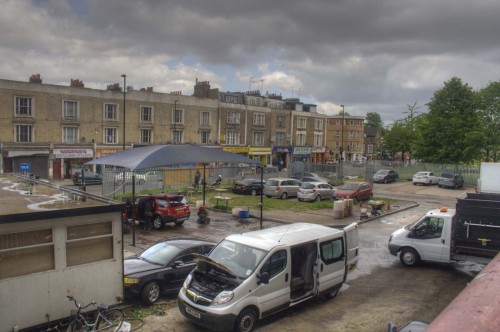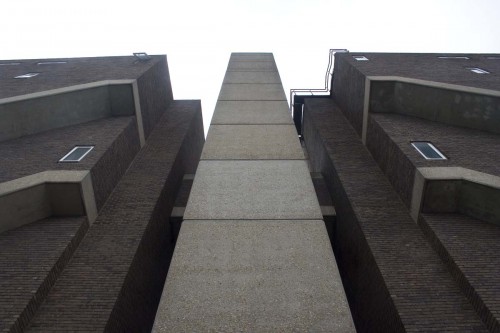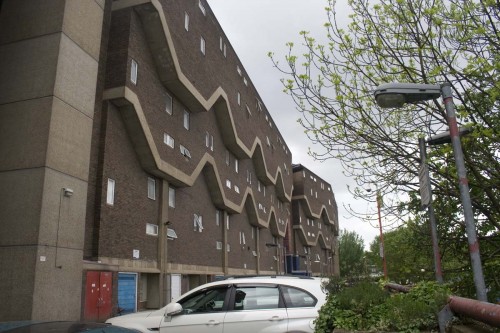If you travel by train through Brixton, then you might have noticed through your windows just to the East of the town, a massive brick barrier.
A vast edifice with small windows hinting at occupation and concrete escutcheons zigzagging along the brick wall. This is housing, but housing based less around the needs of the occupants than the requirements of what never arrived — a motorway.
People are housed in a barrier, a thick high brick barrier built as a wall to deflect the sound of motor cars rushing past. People housed in a building designed less to house them, than as a convenient side-function of a wall needed as a consequence of the rapacious needs of the motorist.
In the 1970s, the Greater London Council proposed a massive flyover through Brixton that would have run over Coldharbour Lane, much as the Hammersmith Flyover does in the West.
What was known as the South Cross Route came surprisingly close to being approved, and indeed some demolition work was carried out, but fortunately, political squabbles held the whole thing up just long enough for people to see sense that the motor car was not a metal God to be worshiped regardless of how it ripped through communities.
So the massive flyover was cancelled, but not before what is officially known as Southwyck House was built alongside where the flyover would have gone.
Its design is entirely dictated by the flyover — the high massive wall of brick was built explicitly to repel the noise of the motorway. The small windows lead onto internal facilities, not bedrooms and lounges.
The concrete overhangs and zig-zag shape a rudimentary method of breaking up the noise of the motorist.
Southwyck House is a barrier, and not unsurprisingly, known locally as Barrier Block. Curiously, had the flyover been built, we might look at it today as a wise and clever design, but shorn of its primary function, it is left with just its secondary task — to house people.
And the people were reluctant to come. Squatted in by some, it later became notorious for crime and drugs in the early 1980s.
The monolithic block was later split into three separate units to break up the pedestrian rat-runs that had perpetuated crime, although they have have limited effect on the drugs and other social problems.
Two inserts at either end of the barrier block are almost reminiscent of East German watch towers, less facilitating access for residents than watching over them. The steel entrance and glass blocks are more designed to withstand abuse than welcome visitors.
Two noisome corridors on either side lead to the residential estate behind the barrier, but are even less welcoming than the watchtowers.
In the middle, a steel staircase encased in steel with steel steps does nothing to reduce the oppressive sensation. If a staircase could feel like a prison, then these seem especially designed to achieve that.
It’s almost as if the council thinking, this is a bad building, so how can we make it worse, got their wish, and lavished millions less on making it a more pleasant place to live in, and hence crime less likely, than simply surrendering to what they have decided is the inevitability of the situation, and turning the building into a prison in all but name.
A holding cell for inmates who they presume will soon be moved to the nearby Brixton Prison instead.
Municipal intrusions aside though, it is the sheer mass of monotonous brown brickwork that dominates the aesthetic. High walls line lower garden spaces creating narrow brick valleys at the foot of the barrier.
The barrier looms over the rest of the estate that lies behind it, overlooking the residents below.
Incidentally, one of the young local councilors who approved the building plans was a John Major who lived on the local road, who later went on to describe it as an example of “grey, sullen wastelands, robbing people of self-respect”. Probably the only redeeming feature is the legacy of the road plans, as a wide open space remains outside barrier, although in one place used by a car wash, the greenery is not entirely unpleasant.
As a block, curiously, the barrier side looks the least offensive side. It retains its brutal necessity untouched by signs of human occupation. It is however the inserts added recently to try and cut down on crime that have actually despoiled the building and made it look more like the Brixton Prison that passersby often mistake it for.
Southwyck House is a sad near miss of a building, a single moment that survived from plans that could have seen Brixton flattened then replaced with high rise towers and motorways.
Some more photos





















There are a couple more examples of barrier blocks in London, both on the proposed “Ringway 1”. The first is on the A12 East Cross route, on one of the few completed sections of the project, the other is visible from the Overground between Kilburn High Rd & South Hampstead on Rowley Way.
The Ringways project fascinates me!
It’s not nearly as bad as it was, and I gather the flats are really nice inside.
Brixton itself is a very different place to what it was in the final 20 years of the last century.
Fascinating & impassioned post with some really interesting links & photos that are more interesting & informative than beautiful but that is as it should be for an estate that you (I think rightly) have only criticism rather than any praise. I’ve never wandered around it or tried to photograph it myself but have walked & risen past it many times, though I do suspect it could only ever be truely judged by someone who lived there. However it is an interesting if definitely not beautiful example in the history of brutalist architecture. Brutalist architecture can be beautiful, albeit that I think it can only work as architecture if it keeps people warm (or cool in hotter parts) & dry, and sits comfortably in the streets and spaces of its city. This does not create civilised streets or look beautiful in any light but it’s zig-zags or crenellations, which I’ve always thought expressions of stairs but I like the idea that they were to deflect noise, are visually striking and memorable, which is no bad thing. Your photos would be a good addition to a Tumblr I follow http://architectureofdoom.tumblr.com/
There is a huge barrier block in Portsmouth (that actually serves the purpose with the M275. Oppressive brown hulk of a building/s similar in size to this one (possibly bigger?). Depressing welcome to what is otherwise a great city if you come in by car.
Been considering running a blog like this one for a while, heh, maybe it could feature?
That shit hole! I had the delight of living there in the mid 80’s. It may be an interesting “piece” of architecture which is seen as a symbol of social history, utilitarian housing for the proliteriat or whatever tag you may choose to add.
The interior of the flats were ok, most of them had 2 floors, a staircase, maybe to give the sense of living in a house, a little micro bubble of a safe haven,an ode to a utopian life.
The reality rather different, step outside into the real world,you had to watch your back.
Long, long bleak corridors,strip lighting to create an even more cruel sense to this place.
Endless little 2-bit street gangs causing trouble,thinking they ruled the place and above the law,in a way they were, the police didn’t really give a damn nor the council.
Stairwells stinking of stale urine,often enough used syringes to be found.
Heroin and crack addicts waiting in the stairwells for the dealer.
There was an infamous shooting gallery which just added to the drama and troubles of this place.
In winter this place was truly grim and bleak, only saving grace the little bubble you lived.
The lighting was cruel and cutting in the communal areas at night in winter,that’s if it worked.The stinking lifts,often not working.
My flat mate and I were burgled in our sleep.
There was a vague sense of community there,if you wanted,few could be bothered.
I may say all this,at the time it had a vague sense of appeal living there,from outside it felt rather mysterious.
Truth is it was depressing living there and I was glad when I left.
I haven’t been to Brixton for over 15 years, apparently it’s been ‘gentrified’